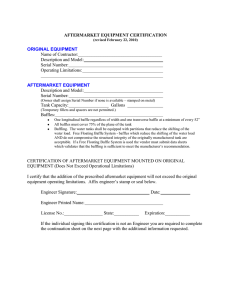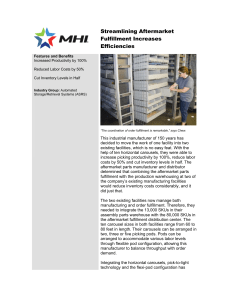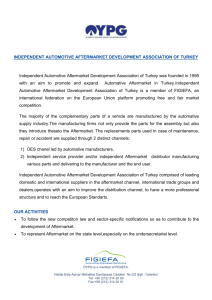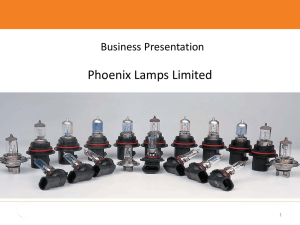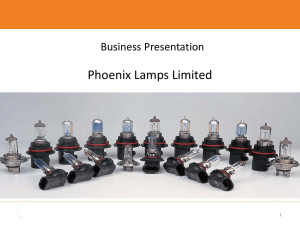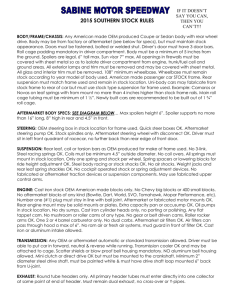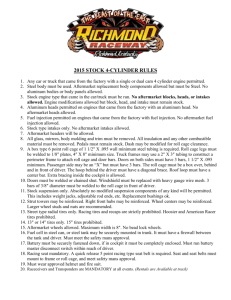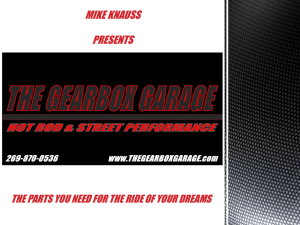Profiting From Spare Parts
advertisement
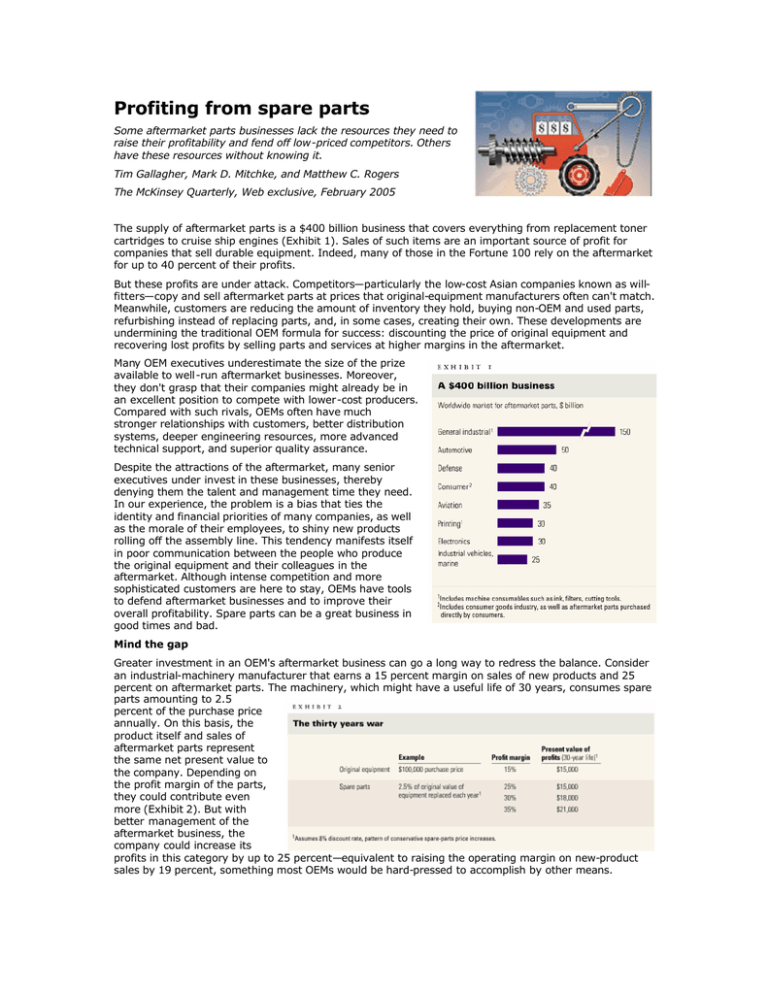
Profiting from spare parts Some aftermarket parts businesses lack the resources they need to raise their profitability and fend off low-priced competitors. Others have these resources without knowing it. Tim Gallagher, Mark D. Mitchke, and Matthew C. Rogers The McKinsey Quarterly, Web exclusive, February 2005 The supply of aftermarket parts is a $400 billion business that covers everything from replacement toner cartridges to cruise ship engines (Exhibit 1). Sales of such items are an important source of profit for companies that sell durable equipment. Indeed, many of those in the Fortune 100 rely on the aftermarket for up to 40 percent of their profits. But these profits are under attack. Competitors—particularly the low-cost Asian companies known as willfitters—copy and sell aftermarket parts at prices that original-equipment manufacturers often can't match. Meanwhile, customers are reducing the amount of inventory they hold, buying non-OEM and used parts, refurbishing instead of replacing parts, and, in some cases, creating their own. These developments are undermining the traditional OEM formula for success: discounting the price of original equipment and recovering lost profits by selling parts and services at higher margins in the aftermarket. Many OEM executives underestimate the size of the prize available to well-run aftermarket businesses. Moreover, they don't grasp that their companies might already be in an excellent position to compete with lower-cost producers. Compared with such rivals, OEMs often have much stronger relationships with customers, better distribution systems, deeper engineering resources, more advanced technical support, and superior quality assurance. Despite the attractions of the aftermarket, many senior executives under invest in these businesses, thereby denying them the talent and management time they need. In our experience, the problem is a bias that ties the identity and financial priorities of many companies, as well as the morale of their employees, to shiny new products rolling off the assembly line. This tendency manifests itself in poor communication between the people who produce the original equipment and their colleagues in the aftermarket. Although intense competition and more sophisticated customers are here to stay, OEMs have tools to defend aftermarket businesses and to improve their overall profitability. Spare parts can be a great business in good times and bad. Mind the gap Greater investment in an OEM's aftermarket business can go a long way to redress the balance. Consider an industrial-machinery manufacturer that earns a 15 percent margin on sales of new products and 25 percent on aftermarket parts. The machinery, which might have a useful life of 30 years, consumes spare parts amounting to 2.5 percent of the purchase price annually. On this basis, the product itself and sales of aftermarket parts represent the same net present value to the company. Depending on the profit margin of the parts, they could contribute even more (Exhibit 2). But with better management of the aftermarket business, the company could increase its profits in this category by up to 25 percent—equivalent to raising the operating margin on new-product sales by 19 percent, something most OEMs would be hard-pressed to accomplish by other means. Yet for many companies, the performance of aftermarket businesses is a mere afterthought. Executives tend to have only a limited understanding of how aftermarket sales contribute to profits and, as a result, miss opportunities to link spare parts to the development or sale of original equipment. Moreover, the executives who manage the aftermarket business are frequently left out of sales and product discussions that reach decisions directly affecting its profitability and its capacity for serving customers. The issue can be broadly characterized as a communication gap. OEMs with healthy aftermarket businesses know that communication between the units dealing with original equipment and aftermarket sales is vital. Many companies, however, don't understand the relationship between the value of original equipment and of aftermarket parts. The result is value-destroying behavior, such as the use of arbitrary aftermarket discounts to sweeten deals for new products. Consider the case of the sales force at a leading North American manufacturer of industrial equipment. Under pressure to meet sales targets in a sluggish market, the company offered too many spare parts as incentives to close sales involving long-term contracts. Most of these deals were brokered in 11th-hour negotiations that excluded managers from the businesses dealing with aftermarket parts. Although the contracts included price escalation clauses, they were detrimental to the spare-parts business in three important ways. First, the terms of the contract, which allowed the OEM to raise aftermarket prices by a certain amount every year, prevented the company from pricing its parts against competitors. To make matters worse, the price escalator was based on a raw-materials index that corresponded poorly with the actual costs and risks the aftermarket business was likely to face. Third, the aftermarket business had to offer the prices set by these long-term agreements to a wider group of customers that had already received lowest-price guarantees. Unsurprisingly, such lapses cost the company millions of dollars in potential profits. Aftermarket sales representatives can avoid this kind of problem by opening lines of communication with their counterparts who sell original equipment and with product-development teams. All sides should work together to consider the total revenue stream that can be generated from the time original equipment is sold until it is retired from the field. Older machines that consume large quantities of high-margin spare parts and services, for example, could be more profitable than the new ones with which the OEM sales force is seeking to replace them. To preserve both income streams, OEMs can try to place their used equipment with customers (such as companies in developing countries or, sometimes, the customers of competitors) that aren't likely to buy their new equipment. Some OEMs upgrade or modify equipment even at the expense of new sales: granting passenger airliners a new lease on life by converting them to freighte rs, for example, can add decades of spare-parts revenues that otherwise would be lost. Often, technical resources flow freely to new products at the expense of improvements to spare parts, regardless of their profit potential. An aftermarket business might have only a small engineering staff lacking the authority to alter specifications without the approval of the OEM product-engineering group. In many cases, requests to redesign older spare parts receive a low priority because companies regard the benefits as insignificant or because implementing the changes seems too difficult given the installed base. Competitors can exploit this kind of sluggishness to design and market lower-cost alternatives that take advantage of new production technologies and cheaper materials. Better marketing Customers might purchase new equipment only once every few years, but they buy parts all the time. Thus the aftermarket business is one of the few constant connections that customers have with a brand, and every interaction shapes their perception of its value. The better the quality of (and the service for) aftermarket parts, the better the brand image. OEMs that have good relationships with their customers also benefit from the ability to gather valuable information that helps them develop better products for both the original and the aftermarket businesses. Most companies can improve their performance by being smarter about how they segment aftermarket customers, by keeping parts up-to-date, and by learning to price products or services more adroitly. Customer segmentation Many managers of OEM aftermarket businesses complain that it is hard to compete with low-cost competitors that cherry-pick the highest-margin parts and customers, as will-fitters do. OEMs frequently feel obliged to supply parts for even their oldest models to protect their reputation, if nothing else. But there are other ways for them to win, even given the constraints. First, consumers of aftermarket parts don't always rank price among the most important considerations when deciding what to buy. In a recent survey 1 of managers responsible for purchasing industrial commodities, 64 percent of the respondents identified factors other than price as the key influence on their decision. The supplier's reputation, the consistency of a product's quality, the speed of delivery, and technical support were most important to more than 40 percent of the respondents. Once an OEM understands this truth, it can offer several packages of parts and services, perhaps under different brand or package names, at various price points and through a number of distribution channels. The key to executing such a strategy is segmentation. Companies routinely segment customers of their OEM businesses but tend not to apply the same rigor to the aftermarket. Even when they do, they sometimes apply the same methods to both groups. Yet the criteria for grouping customers when a company markets new equipment might not be relevant when it groups the same customers in the aftermarket. A customer highly focused on the acquisition cost when buying a new piece of machinery, for example, could be less sensitive about the price of parts and components in the aftermarket; other considerations, such as reliability or the level of technical support, might hold sway. Some aftermarket businesses don't try to segment at all. One commercial vehicle company in North America delivered the same level of aftermarket service—from the time it took to develop a price quote to delivery times for parts—to all of its thousands of customers, whether they were buying all of their parts from the OEM or merely shopping around. The company decided to learn more about the needs and buying patterns of its customers to ensure that only the best ones receiv ed the highest level of service. Segmenting them enabled managers to create tailored packages that provided clear service levels. Surprisingly, most customer segments thought that service had improved, even where the level had actually fallen. Keeping parts up-to-date OEMs that consistently update aftermarket parts prevent would-be competitors from introducing their own higher-performing or lower-cost versions. True, redesigning some parts might not make financial sense and could disrupt the maintenance practices of customers. But there are often good opportunities to improve the performance of a part in ways that benefit both them and the manufacturer and to standardize replacement parts across models. Consequently, an important element in updating parts is communication with customers: However valuable a design change might be, unless the manufacturer markets the improvement properly, they will see only the disruption in coping with a different-looking part or a new part number. As a result, they might continue to order the old part even after an updated version became available, thereby saddling the manufacturer with the cost of building and selling two parts instead of one. Taking advantage of opportunities to redesign parts and streamline catalogs can be particularly tricky for OEMs making durable goods such as aircraft and power generation equipment, whose designs might be decades old. Original drawings and engineering specifications may be difficult or impossible to locate. By contrast, low-cost competitors are likely to focus on a handful of parts they understand intimately —an approach that enables them to offer compelling value. Customers might even view them as having superior products and insight. Getting the price right Pricing aftermarket parts is another problem for OEMs. For one thing, prices often reflect initial product design, testing, and other costs that willfitters don't incur. Historically, OEM parts have set the upper price limit in the marketplace, or a price umbrella. If the OEM tries to compete purely on price, competitors follow suit, initiating a downward, value-destroying price spiral. Many OEMs manage thousands of spare parts, which vary widely in price, cost, and the frequency of orders. Some companies try to duck the task of pricing individual parts by using a cost-plus model to set general expectations for gross margins. This approach results in prices with no real relevance to the parts' potential value. At first, the time required to set prices might fall, but OEMs that don't understand the real value of their parts end up giving away the store. Even in aftermarket businesses that manage thousands of parts, some simple approaches to differentiated pricing can capture much of the value available. One North American transportation manufacturer divided its parts into three categories: those facing no, some, or heavy competition. The company then tried to understand why its individual customers bought parts. Were they needed for emergency repairs, in which case the customers were unlikely to shop around, or were they purchased frequently, so that, as with milk, everyone had an idea of what they should cost? The subsequent adjustments, which raised prices on some parts and lowered those on others, improved the company's gross margin on aftermarket parts by no less than 30 percent. Such an approach, however simple, can require aftermarket businesses to bolster the data they gather about their parts: they will need to know how components are used in the field, for instance, and where competitors are making inroads. Often this information already resides in the company's field-engineering or customer support groups, though a process for using the data to set aftermarket prices might be lacking. Companies can add value not only by introducing differentiated pricing but also by carefully reviewing and updating their supply chain and manufacturing costs, particularly for older, infrequently ordered parts. One industrial company found that it sold 5 percent of its parts at a loss because it had based its cost estimates for them on out-of-date batch-manufacturing and inventory costs. Raising only the prices of parts with negative margins increased the profitability of the OEM's aftermarket business by almost 10 percent. Even top-performing aftermarket parts businesses usually have room to improve, particularly in the way they link up with the OEM side of the company, in how aggressively they pursue opportunities, and in their pricing strategies. Such improvements can increase the profitability of aftermarket businesses, help their customer relationships, and—given the time horizons of many such businesses—contribute significantly to shareholder value. An opportunity in aftermarket services The profitable possibilities in spare parts are complemented by a broader opportunity: many well-known companies have increased their focus on the growth potential of aftermarket services. In the consumer market, for example, The Home Depot and Lowe's were among the first companies to recognize the chance to expand beyond the doit-yourself crowd by offering installation services. In the business-to-business market, GE Healthcare and Otis Elevator provide cost-effective service on equipment manufactured by their competitors, thereby gaining recurring profit streams and a leg up on the competition when customers upgrade or replace equipment. Service leaders such as Caterpillar use their brand reputation, differentiated service offerings, and robust distribution and service networks to command premium prices for original equipment, spare parts, and service alike. Some companies have difficulty making services grow, because the service function has developed out of a legacy of product support, primarily to facilitate ongoing product and spare-parts sales. This heritage raises several issues: the service organization remains biased toward a one-size-fitsall approach, fails to understand the cost to serve and how it varies by customer, and isn't appropriately staffed or structured to achieve the full profit potential of the business. To overcome these disadvantages, companies must clarify their strategies by answering a few important questions: What is the service mandate? Many successful after-market service providers can trace a clear evolutionary path from their origins in product warranty support (often reporting to sales) to a stand-alone profit center. At Otis Elevator, for example, service has evolved into a focused business group that accounts for a disproportionately large share of the company's overall profits. In contrast, the maintenance of medical-diagnostic equipment generally remains a product support function. The right mandate for a particular company can vary but must be agreed upon and supported throughout the organization if services are to prosper. Successful service providers tend to define their mandate by analyzing the role of services in the economics of a product's life cycle and by estimating their ability to influence future purchasing decisions. What service levels should be offered? This question sparks debate in most service operations. Companies tend to get feedback disproportionately from dissatisfied customers—feedback that is often amplified by the company's own sales force. For stand-alone services, an understanding of what customers are willing to pay for can at least partially answer the question. The issue may be more complicated in situations where service is a giveaway to sweeten product deals. In either case, a one-size-fits -all approach to service levels typically results in high costs or low customer satisfaction, and sometimes both. Tiered service offerings, carefully structured, can reduce the cost to serve and attract new customers while maintaining or enhancing customer satisfaction, but only if a company uses a clear and unbiased understanding of its customers' needs, economics, and profitability, by segment, to develop such offerings. How do services fit into the organization? When service becomes an explicit growth priority, tension can develop between the product and service functions, particularly concerning sales activities for shared customers. As companies focus more intensely on the growth of services, they must think carefully about reporting lines, the responsibility for decisions, and incentives. If the primary mandate is to support product sales, for instance, it might make sense for the service group to report to the product group. But if the mandate is to generate a profitable portfolio of service contracts, a separate business unit for services may be in order. Clarifying the answers to these fundamental questions is the key to unlocking the potential of aftermarket services. As companies better understand the profit possibilities and the competitive necessity of offering such services, this opportunity, we believe, could be the next battleground for competitive differentiation. — Theodore M. Dezvane and Travis W. Fagan About the Authors Tim Gallagher is a consultant in McKinsey's Los Angeles office, Mark Mitchke is a principal in the Pacific Northwest office, and Matt Rogers is a principal in the San Francisco office.
